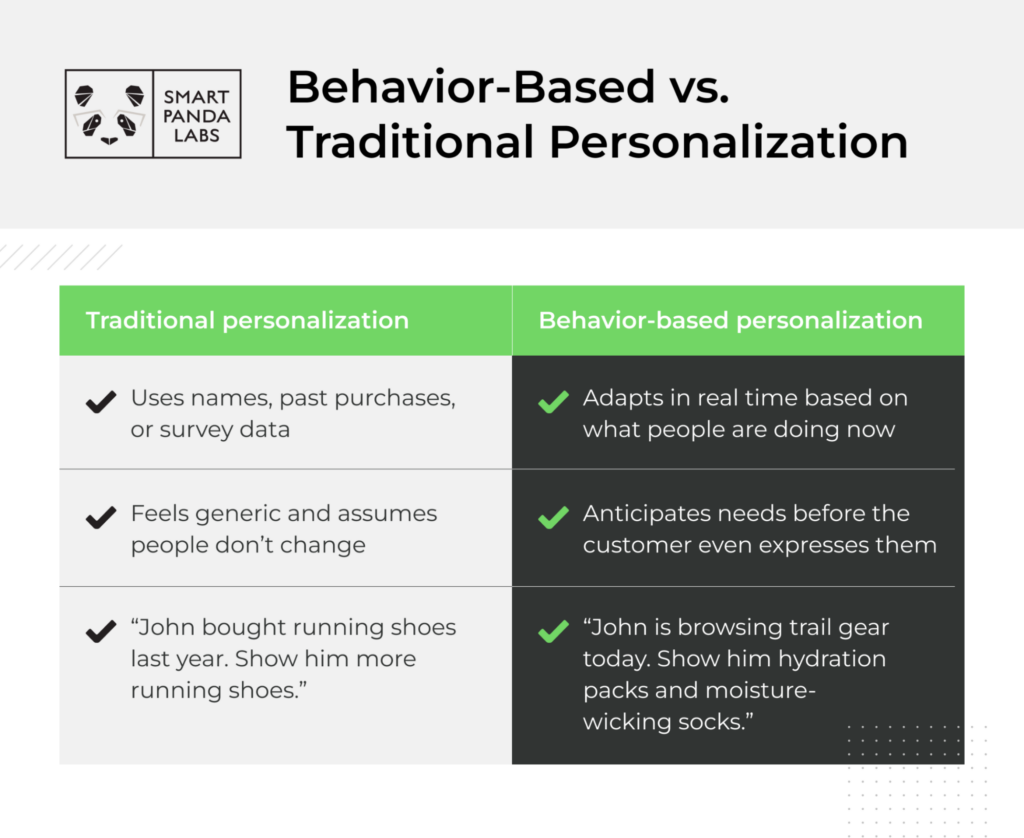
Behavior-Based vs. Traditional Personalization
First-name personalization feels good. But it’s a lie.
Many companies rely on it because it’s easy. It feels like you’re personalizing people’s experiences.
But the reality is:
It doesn’t drive conversions, and customers see right through it.
Just because an email says, “Hey Jess, we think you’ll love this!” doesn’t mean Jess will actually love it.
The brands winning market share today don’t overuse this basic data point.
They track people’s actions, understand their intent, and act on it in the moment.
A CMO may think their team is doing personalization right—segmenting lists, using first names, and adding recommended-for-you products.
But the results?
Flat.
Low click-throughs.
And even lower conversions.
That is until they make one big shift to behavior-based personalization.
What is behavior-based personalization?
Instead of static data (e.g., past purchases or survey responses), you personalize people’s experiences based on real-time actions.
In other words, customers’ content and communications differ based on how they’re interacting with your CX right now.
Imagine you’re shopping for a winter jacket.
You scroll through several sites and product listing pages, clicking a few options.
✅ Brand A shows you more jackets
⭐️ Brand B highlights insulated ones (as it notices you’re clicking those)
You add one item to your cart on each site.
Now:
✅ Brand A keeps showing you outerwear
⭐️ Brand B suggests thermal base layers and waterproof boots—guiding you to prep more thoroughly for cold weather before you even think about it
Which experience feels more helpful?
Traditional vs. behavior-based personalization
Behavior-based personalization isn’t just about more relevant recommendations.
It creates a frictionless, intuitive experience where customers feel like you get them.
Because when people feel understood, they buy.
Here’s how the two types compare:

Pushing static messages based on outdated data? Out.
Meeting customers with relevant offers in their moment of need? In.
Here are four ways you can do the same:
1. Track real customer actions
Mediocre brands track demographics. Winning brands also track behavior.
The real question isn’t just “Who is our customer?”
It’s “What is that customer doing right now?”
Specifically:
→ Which pages did they visit?
→ What products did they click on but not buy?
→ How long did they engage with specific content?
Use that information to guide the next step in their buying journey.
For example:
A customer browses three travel credit card options, spends five minutes comparing perks, and abandons the page before applying.
These insights tell you more than any demographic data ever could: this person is actively researching but hasn’t made a decision.
A brand that tracks this behavior can identify and act on hesitation (e.g., a popup link to speak to the support team).
Takeaway: Don’t just collect data—spot patterns. A customer’s actions can tell you what they need before they have to.
2. Serve dynamic content (when people need it most)
Your website and emails should evolve based on this real-time behavior.
Instead of showing the same content to everyone, adjust what someone sees based on their latest actions.
You can do this with:
→ Smart homepage recommendations. Highlight products based on recent views.
→ Custom category pages. Surface the most relevant items per user.
→ Personalized CTAs. Tailor messaging based on browsing history.
For example:
A healthcare platform notices a user is reading articles about managing back pain.
Instead of leaving them to search for solutions, it automatically highlights a back pain relief guide and virtual consultations with a specialist.
Takeaway: Make the experience feel tailor-made to show customers you understand their specific needs.
3. Send triggered emails
Who you’re emailing matters. But when and why you send it is what drives action.
Many marketing communications rely on broad segments or scheduled sends. But the best emails aren’t just well-timed—they’re triggered by customer intent.
Here are three ways you can use personalized triggers:
→ Post-purchase upsells (“Complete your course bundle with these add-on classes.”)
→ Browse abandonment (“Still thinking about this? Here’s what other hikers love.”)
→ Price drop alerts (“That hotel you viewed is now having a sale!”)
For example:
An airline notices a user checking Italy flight prices twice in one week.
Instead of waiting for a ticket purchase, the action prompts an email with a Rome travel guide or a Florence hotel discount package.
Takeaway: Capture people at peak interest when they’re most likely to act, not after they’ve moved on.
4. Keep testing and optimizing
Your best-performing strategy today won’t have the same impact next month.
Personalization is never “done.”
Customer behavior shifts, trends change, and what worked before might start underperforming.
The only way to stay ahead is to keep measuring, testing, and adjusting for continuous improvement.
Here are three ways you can experiment:
→ Refine recommendation logic. Does “Frequently bought together” convert better than “Because you liked X”?
→ Try different messaging. Does urgency (“Only 3 left!”) or social proof (“51 people bought this last week”) drive more buyers to act?
→ Analyze drop-off points and react. Are people losing interest on product pages or at checkout? Focus on these touchpoints when testing to re-engage them in the moment.
For example:
An online bookstore tests whether “You might like this” vs. “Readers who loved [Book name] also bought this” leads to higher clicks and sales.
Takeaway: Personalization isn’t a set-it-and-forget-it strategy. Evolve your tactics consistently based on actual results.
Behavior-based personalization drives action
Customers don’t want to feel like data points. And they’re already overwhelmed with choices.
What they really need is a brand that makes decisions easier.
That’s why successful companies use behavior-based personalization to:
- Track touchpoints
- Anticipate buyer needs
- Tailor experiences in real time
👉 To make this process feel effortless and natural, you need the right technology and experts who know how to manage it.
(Ready to transform your personalization game? Smart Panda Labs makes it happen.)
Yes, it’s an investment. But the long-term gains are tangible.
Because using my name won’t make me buy.
Showing you understand me will.
READY TO PROVIDE A BETTER POST-CLICK EXPERIENCE?
Get insights and tips to drive more business from less ad spend, more profit from less cost, and more customer value from less churn.